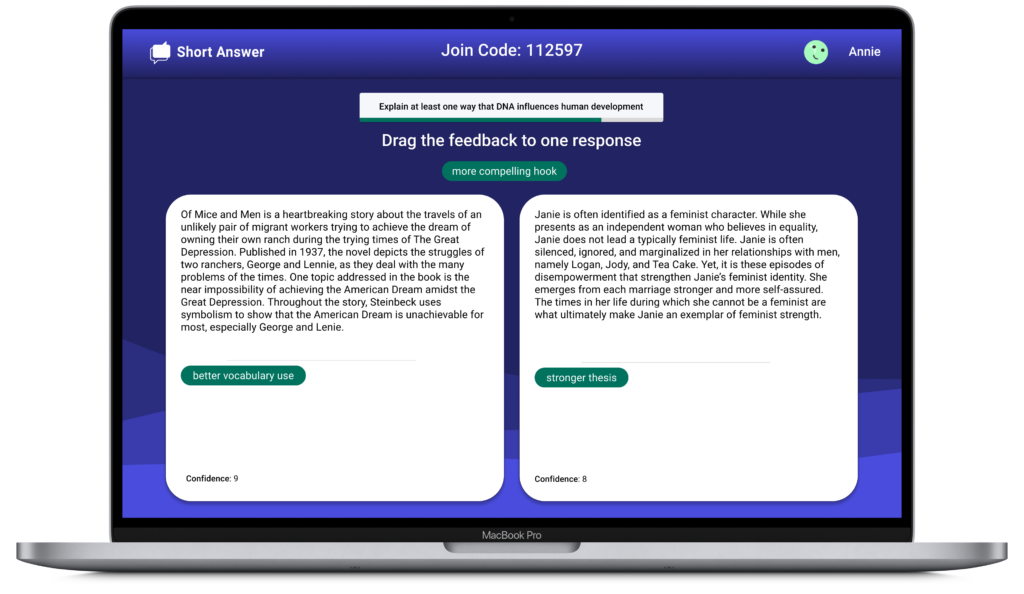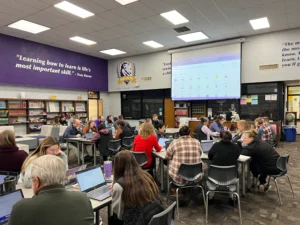To celebrate Short Answer’s official launch into classrooms everywhere this week, we’re kicking off our blog with the topic nearest and dearest to our hearts: how to bring more peer feedback into your classroom. Peer feedback is at the core of everything we do at Short Answer because we believe in its power to create more social, energizing classrooms where all students feel like they have a voice.
On top of improving students’ understanding of class content, peer feedback is also beneficial because it fosters more collaborative and supportive learning environments. When students participate in peer feedback, they are also practicing lifelong skills such as building empathetic relationships and showing respect for others’ opinions even during disagreement.
With all this in mind, here are three ways to introduce peer feedback into your classrooms.
1. Gallery Walks
Students get excited by any opportunity to showcase their creative work in front of classmates. While gallery walks are commonly used as final celebrations of student work (think posters, dioramas, and art), they are underutilized during the “work in progress” stage as a way to generate tons of inspiration for students. Here’s an example of a gallery walk you can do as students are beginning to think through an essay or research project:
1. Students write their thesis or research question on a big piece of paper and tape it up somewhere in the room.
2. Give each student a stack of colorful post-its and sharpies.
3. Students walk around the gallery observing work and attaching their thoughts onto each project using the post-its.
4. Lead a debrief discussion where students can highlight their favorite pieces, analyze common themes among the work, and talk about next steps for improvement.
Every student comes away from the activity with plenty of food for thought, as well as the enduring feeling of excitement that comes with putting an original idea out into the world. Students even get the chance to see which classmates might be working on a similar idea, increasing the opportunity for collaboration.
As always, you can have students post their work anonymously. It’s always a good idea to go over norms for giving open-ended feedback, such as how to show respect for others’ work. Scaffolded feedback frameworks (see our handouts at right) can help guide students in the process as well.
Resource: Scaffolded Peer Feedback Worksheets
2. The Active Warm Up

Need to get your students moving during the mid-afternoon post-lunch lull? This one’s a fun one. You may have done a rock-paper-scissors tournament in a similar fashion.
1. As students sit at their tables in groups, pose a warm-up question about material from the previous lesson.
2. Students write their responses anonymously, crinkle up their paper, and mix the paper balls around the table so that everyone is left with someone else’s answer.
3. Students partner up and debate which response is stronger. The pair then becomes a team that backs the winning response and finds another new team of two to debate.
4. The process continues, with students physically moving around the room, until there are two large teams of students left to determine the ultimate winner.
Students evaluate and debate each other for what makes for strong responses and get a quick recap of the material they just learned, all while getting discussion-based feedback on work. Whoops, cheers, and claps abound, we promise.
3. Writer's Workshop
It can definitely be scary to have your earliest, first-draftiest work be put in front of other people when you don’t feel ready for it. For students, peer feedback at this stage can be the perfect motivator to get out the first draft jitters in a low-judgment, supportive environment.
Have students come into class with a small but meaningful section of an essay, such as an intro paragraph or conclusion. It helps during the feedback session if students come prepared with the same section; that way, class discussion revolves around the qualities of what makes for a strong section and every student comes away with tangible strategies for how to improve their writing.
For a quick way to get all student’s structured feedback on their work, use Short Answer’s All In activity. As a class, collectively determine what criteria are important to evaluate work on. Have students copy-and-paste their writing into Short Answer, and let the feedback fly! The process of peer evaluation will introduce students to a wide variety of their peer’s work and help them reflect on how to improve their own writing. (Try All In in your classroom today!)
For more on how to use Short Answer for writer’s workshops, check out our subject guides for English and Social Studies.

In Short
There’s no limit to the number of ways to introduce peer feedback activities into classrooms of any subject. As we’ve seen here, peer feedback can be relatively low-lift to set up and reap a ton of benefits for both your students and you. As our cofounder Adam likes to say: “it’s all juice, no squeeze.”
Teachers, let us know in the comments below or tweet us @myshortanswer with all the great ways you’re using peer feedback in your classroom. We’d love to spotlight you and share all the great work you do every day. Thanks for all that you do!







